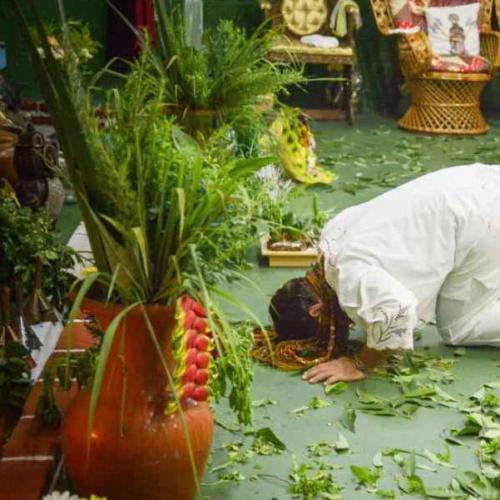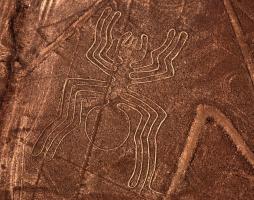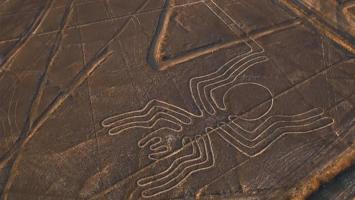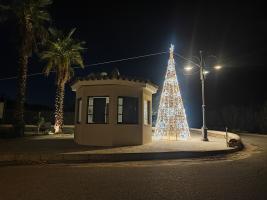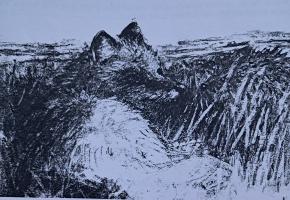6 - The seven lines (part 2)

I hope
Male orixá, of Yoruba (Nagô) origin, widely worshiped in Brazil, where he is usually considered the most important deity of the African pantheon. In Africa it is worshiped with the name of Obatalá. When, however, the blacks came here, as slave labor in agriculture, they brought with them, in addition to the name of the Orixá, another way of referring to him, Orixalá, which means, orixá of the orixás. In a contracted version, the name that became popular is OXALÁ.
This relationship of importance comes from the organization of African deities being a symbolic way of codifying the rules of behavior. In the precepts, there are all the basic matrices of family and tribal organization, of the possible attitudes, of the different paths for the same issue. For the same problem, different orixás propose different answers - and there is rarely a social agreement in the sense of establishing one of the solutions as correct and the other not. African jurisprudence in this sense prefers to live with opposites, establishing, at most, that, in the face of an impasse, Ogun does this, Iansã does that, for example.
Thus, Oxalá does not have more powers than the others, nor is he hierarchically superior, but deserves everyone's respect for representing the patriarch, the head of the family. Each member of the family has their functions and the right to interrelate on an equal basis with all the other members, which the legends of the Orixás confirm through the independence that each one maintains in relation to the others. Hopefully, however, it is what brings with it the memory of other times, the solutions already found in the past for similar cases, deserving, therefore, the respect of all in a society that actively worshiped their ancestors. It represents empirical knowledge, in this case placed above the specialized knowledge that each Orisha can present: Ossâim, the liturgy; Ochosi, hunting; Ogun, metallurgy; Oshun, motherhood; Yemanja, education; Omolu, medicine - and so on.
If, on this side, Oxalá deserves more prominence, considering him superior to others ( which is not implied as power, but deserving respect for the title of Orixalá ) came from European colonization. The Jesuits tried to introduce blacks into Catholic cults, a step considered decisive for the mentors and ideologues who tried to adapt them to the society where they were forced to live, based on codes completely foreign to them. Pure and simple repression was very efficient in these cases, but it was not enough. Revolts were constant. In some cases, they realized that syncretism was the best way out, and they tried to convince black people that their Orixás also had a place in white culture, that the entities were practically the same, only with different names.
Some slaves believed them. Others took advantage of the almost obligatory practice of Catholic cults to, when carrying out them, carry out true Umbanda cults, only masked by the official religion of the colonizer. Having clarified this issue, we do not deny the unique and very important functions of Oxalá in the face of Yoruba mythology.
It is the potential generating principle, responsible for the existence of all beings in heaven and earth. It is what allows conception in the masculine sense of the term. Its color is white, because it is the sum of all colors.
Because of Oxalá, the color white is associated with Candomblé and with Afro-Brazilian cults in general, and no matter which saint is worshiped in a terreiro, nor the Orixá with the head of each saint, it is common for them to dress in white, tribute to the Father of all Orixás and human beings.
If she likes and wants to wear clothes with the colors of her ELEDÁ (first head Orisha) and her AJUNTÓ (auxiliary adjutants of the head Orisha) there will be no problem, just depending on the orientation of the spiritual dome leading the terreiro.
According to legends, Oxalá is the father of all the Orixás, with the exception of Logunedé, who is the son of Oxóssi and Oxum, and Iemanjá, who has a controversial affiliation, with Odudua and Olokum being most cited as his parents, but effectively Oxalá was never appointed. like your father.
His preferential field of action is the religiosity of beings, to which he sends all the time his stimulating vibrations of individual faith and his radiations that generate feelings of religiosity.
Faith! Here is what best defines the Orisha Oxalá.
Yes, we love brothers in faith in Oxalá. Our beloved Father of Umbanda is the Orisha that radiates faith on a planetary and multidimensional level.
Oxalá is synonymous with faith. He is the Throne of Faith that, seated in the Divine Crown, radiates faith in all senses and to all beings.
Orixá associated with the creation of the world and the human species. In Candomblé, it presents itself in two ways: young – called Oxaguiam, and old – called Oxalufam. The symbol of the first is an idá (sword), the second is a kind of metal staff, called ôpá xôrô. The color of Oxaguiam is white slightly mixed with blue, of Oxalufam is only white. The day consecrated for both is Friday. Oxalá is considered and worshiped as the greatest and most respected of all the Orixás of the African Pantheon. He is calm, serene, pacifying, he is the creator, therefore respected by all Orixás and all nations.
The vibration of Oxalá dwells in each one of us, and in every part of our body, however veiled by our imperfection, by our degree of evolution. It is the Christ within, and at the same time cosmic and universal; Which never left unanswered or without comfort a single human heart, whose appeal reached him. What are you looking for, in the midst of humanity, for men capable of listening to the voice of wisdom and who can respond to it, when asking for messengers to transmit to their flock: "I am here; send me".
Is it Jesus?
The image of Jesus Christ is an obligatory figure in a place of honor in all Umbanda Centres, Terreiros or Tents, in an elevated place, usually highlighted with intentionally prepared lighting, in order to conform a kind of aura of diffused light around it. Oxalá is honored in the representation of the one who was the "beloved son of God among men"; however, within this syncretism, the heritage of African tradition remains: "Jesus was sent; he was flesh, he was born, he lived and he died among men"; Oxalá coexisted with the formation of the world; I wish it was already before Jesus was.
I hope, like Jesus, he provides his children with the best way to practice charity, that is, giving with the right hand to receive with the left in eternity and thus be able to walk the path of light that will lead them to their Divine Master.
Features
| Color | White |
| String of Accounts | White and milky Beads and Seeds. White Firms. |
| herbs | Oxalá Rug (Boldo), Saião, Cologne, White Basil, White Rose, Cotton Leaf, Sandalwood, Mallow, Patchouli, Lavender, Clove Leaf, White Snow, Orange Leaf.(In some houses: pennyroyal, chamomile, hat leather, coriander, white geranium, rue, lemon balm, wild rosemary, mint, sunflower leaves, white agapanthus, water hyacinth (white flower gulf), garden rosemary, table rosemary, vanilla, camellia, carnauba, india), pichuri bean, tonka bean, white grape vine leaf, passion fruit (flowers), macela, jerusalem palms, umbuzeiro, beach parsley) |
| Symbol | 5 pointed star. (In some houses, the Cross) |
| Nature Points | Deserted beaches, bare hills, fields, mountains, etc... |
| Flowers | White lilies and all flowers that are that color, roses preferably without thorns. |
| essences | Aloe, musk, lily, benzoin, wildflowers, orange blossoms. |
| stones | Diamond, rock crystal, white pearls. |
| Metal | Silver (In some houses: platinum, white gold). |
| Health | It has no specific health area, as it covers our entire body and spirit. |
| Planet | Sun. |
| Day of the week | All, especially Friday. |
| Element | Air |
| chakra | Coronary |
| Salutation | Exê Uêpe |
| Drink | Mineral water, or sweet white wine or sweet red wine. |
| Animals | White Dove, Snail, White Owl |
| foods | Canjica, Acaçá, Mungunzá. |
| Number | 10 (Oxalufan), 8 (Oxaguiã). |
| Commemorative Date | December 25th |
| Syncretism | Jesus. (Oxaguiã, Baby Jesus of Prague; Oxalufã, Senhor do Bonfim) |
| Incompatibilities: | Palm wine, palm oil, charcoal, dark clothes, red color, cachaça, dark animals. Blades (Oxalufan) |
Assignments
Oxalá's attributions are those of not leaving a single being without the religious support of the mysteries of the Faith. But the being does not always absorb its radiations when his mind is turned to the unbridled materialism of incarnate spirits.
The Characteristics of the Children of Oxalá
The children of Oxalá are calm people, with a tendency to calm, even in the most difficult moments; they earn respect even without making an objective effort to obtain it. They are kind and thoughtful, but never subservient. Sometimes they become authoritarian, but this happens with those who have warrior or authoritarian Orixás as adjutors (ajuntós).
They are very dedicated, capricious, keeping everything always beautiful, clean, with beauty and affection. They respect everyone but demand to be respected.
They know how to argue well, having a penchant for jobs that involve organization. They like to center everything around themselves. They are reserved, but rarely proud.
Their most common defect is stubbornness, especially when they are sure of their convictions; it will be difficult to convince them that they are wrong or that there are other ways to solve a problem.
In the older Oxalá (OXALUFÃ) the tendency translates into grumpy and intolerance, while in the new Oxalá (OXAGUIÃ) there is a certain rage for debate and argumentation.
For Oxalá, the idea and the verb are always more important than the action, and it is not uncommon to find them in careers where language (written or spoken) is the fundamental point.
Physically, the children of Oxalá tend to present a majestic or at least dignified bearing, mainly in the way they walk and not in the physical constitution; he is not tall and thin like the son of Ogun nor as compact and strong as the children of Xangô. Sometimes, however, this way of walking and standing gives way to someone with a tendency to stoop, as if the weight of a long life has fallen on their shoulders, even for someone very young.
In order for the son of Oxalá to have a better life, he must try to awaken within him joy for the things that surround him and try to give in to his natural stubbornness.
Ritualistic cuisine
hominy
White hominy (without that dark and undercooked eye). Place in a white ceramic bowl. Cover with Cotton, Saião Leaves or Snow Whites. Being able to put a bunch of white grapes on top of everything. drizzle with honey
The hunt
Cook 1/2 kg of white corn flour, like angu or porridge. Let it cool a little, and make dumplings. In some houses it is spooned into banana leaves that have been put on the fire and rolled up. Serve after cold.
Obs1) When placing this offering, place it in front of your altar with a glass of water on the top, a 7-day candle on the right, 3 branches of wheat on the left and on the bottom, on top of a white cloth, place a bun cut into three pieces, leave the 7-day candle until the end of the candle and you will see that it has created a downy mildew in the Acaçá, a sign that your request and your faith was well accepted, send everything in a flowery garden or field.
Obs3) The so-called "acaçá flour", which is already ground white hominy, is already on sale in the market, which greatly facilitates the making of Oxalá acaçá.
Mungunzá
Choose 1/2 kg of white hominy (without that dark eye) and soak the night before. The next day, put it to cook with water and salt. When the hominy starts to soften, add the thin milk of 2 coconuts, add the sugar, mix and, if necessary, add more salt. Add the cloves and cinnamon. Dissolve the rice cream in pure coconut milk and add it to the mungunzá to thicken the broth. Serve in deep dishes, like soup.
A fruit table is also appreciated, which cannot have thorns, splinters or lint, such as: mango, pineapple, carambola, cashew apple, etc.
In Candomblé it is the only Orixá that does not require killing, at any time.
The legends of hope: Aguas de Oxal
The day was approaching when it would be held in the kingdom of Oyó, the time of celebrations in honor of Xangô, King of Oyó, where all the Orixás were invited, including Oxalufã. Before heading to Oyó, Oxalufã consulted his babalawo in order to know how the journey would be, the babalawo told him: take three changes of white clothes, because Exú will make your paths difficult. And Oxalufan left alone. The soothsayer then advised him to take with him three white cloths, shore slime and shore soap, as well as to accept and do whatever was asked of him on the way and not complain about anything, no matter what. It would be a way of not losing life.
Walking through the woods he found Exú trying to lift a vat of palm oil on the coast and asked him for help, Oxalufã promptly helped him but Exú purposely spilled the palm oil on Oxalufã and left. Oxalufan bathed in the river, changed clothes and continued on his journey. But later he met Exú again, who this time tried to lift a bag of coal on his back and asked Oxalufã to help him, again Oxalufã helped him and Exú repeated the feat by pouring the coal over Oxalufã, bathing in the river and changing of clothes, Oxalufã continued his journey to Oyó, already close to Oyó, found himself with Exú again trying to lift a barrel of molasses and the story repeated itself. In the fields of Oyó, Oxalufã found a runaway horse from the stables of Xangô, and decided to return it to the owner, before reaching the city, he was approached by guards who found him guilty of the theft.
They mistreated and arrested Oxalufan. He, always silent, allowed himself to be taken prisoner. But because an innocent man was in prison, in the lands of the Lord of Justice, Oyó lived through the deepest drought for seven years. The women became barren and many diseases ravaged the kingdom. Desperate Xangô decided to consult a babalawo to find out what was happening and the babalawo told him: life is imprisoned in its dungeons, an old man suffered unfairly as a prisoner, paying for a crime he had not committed. With that answer, Xangô went to the prison and there he found Oxalufã all dirty and badly treated. He immediately took him to the palace and there he called all the Orixás where each one carried a pot with water from the mine. One by one the Orixás were dropping their waters in Oxalufã to wash it. The king of Oyó ordered his subjects to dress in white. And let everyone remain silent. For it was necessary, respectfully, to ask forgiveness from Oxalufan. Xangô also dressed in white and carried the old king on his back. And he took him to the parties in his honor and all the people saluted Oxalufã and all the people saluted Xangô.
Legend of Creation
Oxalá, "The Great Orixá" or "The King of the White Cloth". It was the first to be created by Olorum, the supreme god. He had a rather stubborn and independent character.
Oxalá was charged by Olorum to create the world with the power to suggest (àbà) and to perform (àse). To fulfill his mission, before departure, Olorum gave him the "bag of creation". The power entrusted to him did not exempt him, however, from submitting to certain rules and respecting various obligations like the other orixás. An Ifá story tells us how. Due to his haughty character, he refused to make some sacrifices and offerings to Exú, before starting his journey to create the world.
Oxalá set out on his way supported by a large tin staff, his òpá osorò or paxorô, a staff for performing ceremonies. At the moment of going through the door of the Beyond, he found Exé, who, among his multiple obligations, had to supervise the communications between the two worlds. Exé displeased with the refusal of the Great Orisha to make the prescribed offerings, he took revenge by making him feel an intense thirst. Oxalá, to quench his thirst, he had no other recourse than to pierce the bark of an oil palm with his paxorô. A refreshing liquid oozed out of him: it was palm wine. He drank it greedily and abundantly. He got drunk and didn't know where he was anymore and fell asleep. Then came Odudua, created by Olorum after Oxalá and his biggest rival. Seeing the Great Orisha asleep, he stole the "bag of creation", went to the presence of Olorum to show him his find and tell him what state he was in Oxalá. Olorum exclaimed: "If he is in this state, go you, Odudua! Go create the world!" Odudua thus left the Beyond and found himself facing an unlimited expanse of water.
He dropped the brown substance contained in the "creation bag". It was earth. A mound was then formed that surpassed the surface of the waters. There, he placed a chicken whose feet had five claws. It began to scratch and scatter the earth over the surface of the waters.
Where it scratched, it covered the waters, and the land was expanding more and more, which in Yoruba is called ilè nfè, an expression that gave rise to the name of the city of Ilê Ifé. Odudua settled there, followed by the other orixás, and thus became the king of the land.
When Oxalá woke up, he no longer found the "bag of creation" by his side. Disgusted, he returned to Olorum. The latter, as a punishment for his drunkenness, forbade the Great Orixá, as well as the others in his family, the funfun orixás, or "white orixás", to drink palm wine and even use palm oil. He entrusted him, however, as a consolation, the task of modeling the bodies of human beings in clay, to which he, Olorum, would breathe life.
For this reason, Oxalá is also called Alamorere, the "owner of good clay".
He began to model men's bodies, but he did not take the prohibition against drinking palm wine very seriously, and on days when he went too far, men left his hands crooked, deformed, lame, hunchbacked. Some, taken out of the oven too soon, came out undercooked and their colors turned sadly pale: they were albinos. All the people who enter these sad categories are consecrated to him and become worshipers of Oxalá.
How Oxalá Became the Father of Creation
Iemanjá, the daughter of olokum, was chosen by olorum to be the mother of the orixás. as she was very beautiful, everyone wanted her for a wife; so the father went to ask orumila who she should marry. orumila ordered him to deliver a wooden staff to each suitor; then they were to spend the night sleeping on a rock, holding the staff so that no one could take it. the next morning, the man whose staff was in bloom would be chosen by orumila as yemanjá's husband. the candidates did so; the next day, the staff of hope was covered with white flowers, and so he became the father of the orixás.
How Oxalá Learned to Produce the Color White
Once, when the orixás were gathered, Oxalá slapped Exu and threw him to the ground, all bruised; but at the same moment exu got up, already cured. So I hope it hit his head and Eshu became a dwarf; but he shook himself and returned to normal. Then I hope he shook Exu's head and it became huge; but exu rubbed her head with her hands and she became normal. The fight continued, until Exu took a little gourd from his own head; white smoke came out of it that took away the colors of hope. I hope he rubbed himself, as Eshu had done, but he didn't get back to normal; then he took the axé out of his head and blew it on exu, who became docile and handed him the gourd, which he hopes he uses to make white people.








